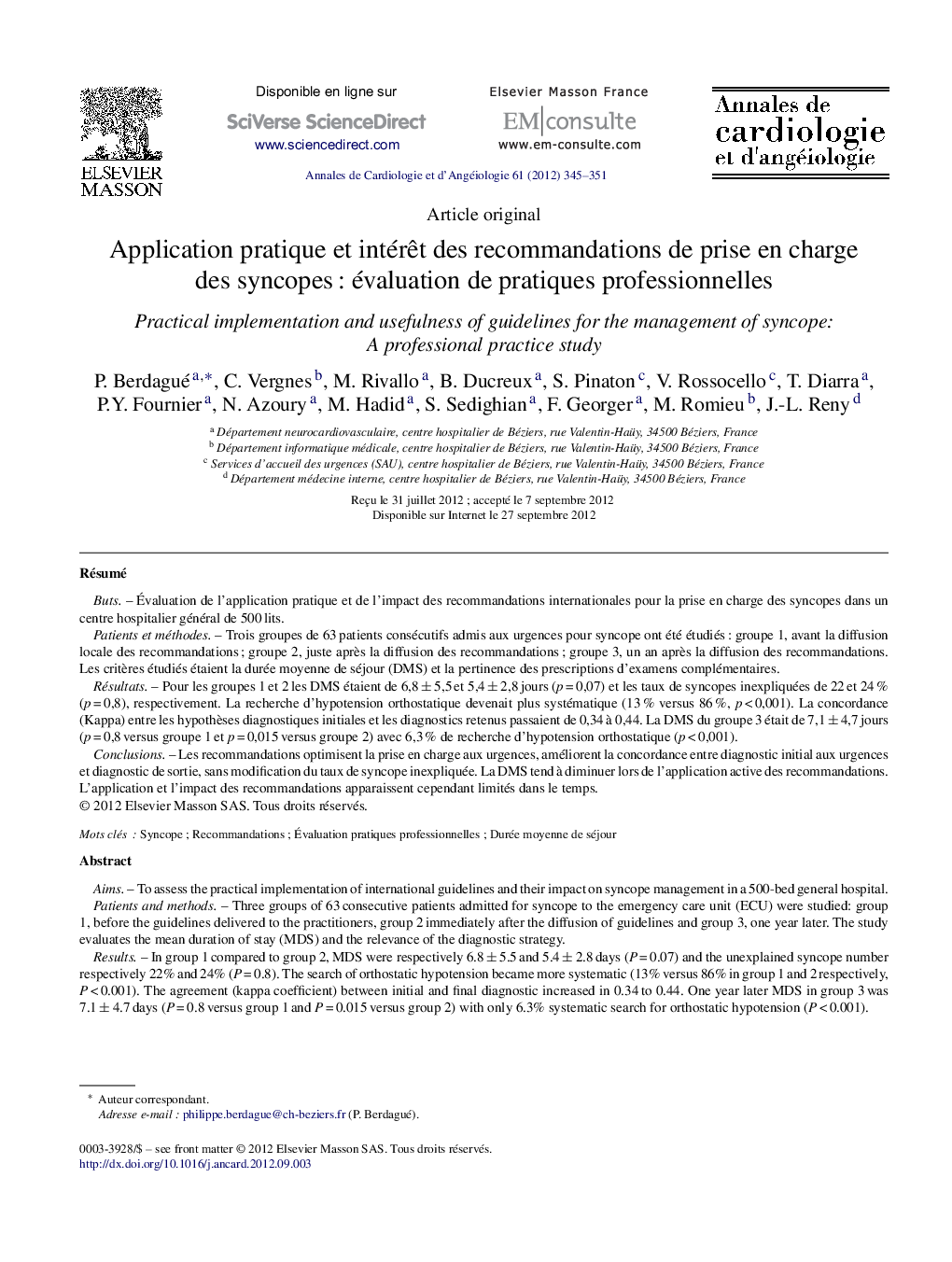| Article ID | Journal | Published Year | Pages | File Type |
|---|---|---|---|---|
| 2868870 | Annales de Cardiologie et d'Angéiologie | 2012 | 7 Pages |
RésuméButsÉvaluation de l’application pratique et de l’impact des recommandations internationales pour la prise en charge des syncopes dans un centre hospitalier général de 500 lits.Patients et méthodesTrois groupes de 63 patients consécutifs admis aux urgences pour syncope ont été étudiés : groupe 1, avant la diffusion locale des recommandations ; groupe 2, juste après la diffusion des recommandations ; groupe 3, un an après la diffusion des recommandations. Les critères étudiés étaient la durée moyenne de séjour (DMS) et la pertinence des prescriptions d’examens complémentaires.RésultatsPour les groupes 1 et 2 les DMS étaient de 6,8 ± 5,5 et 5,4 ± 2,8 jours (p = 0,07) et les taux de syncopes inexpliquées de 22 et 24 % (p = 0,8), respectivement. La recherche d’hypotension orthostatique devenait plus systématique (13 % versus 86 %, p < 0,001). La concordance (Kappa) entre les hypothèses diagnostiques initiales et les diagnostics retenus passaient de 0,34 à 0,44. La DMS du groupe 3 était de 7,1 ± 4,7 jours (p = 0,8 versus groupe 1 et p = 0,015 versus groupe 2) avec 6,3 % de recherche d’hypotension orthostatique (p < 0,001).ConclusionsLes recommandations optimisent la prise en charge aux urgences, améliorent la concordance entre diagnostic initial aux urgences et diagnostic de sortie, sans modification du taux de syncope inexpliquée. La DMS tend à diminuer lors de l’application active des recommandations. L’application et l’impact des recommandations apparaissent cependant limités dans le temps.
AimsTo assess the practical implementation of international guidelines and their impact on syncope management in a 500-bed general hospital.Patients and methodsThree groups of 63 consecutive patients admitted for syncope to the emergency care unit (ECU) were studied: group 1, before the guidelines delivered to the practitioners, group 2 immediately after the diffusion of guidelines and group 3, one year later. The study evaluates the mean duration of stay (MDS) and the relevance of the diagnostic strategy.ResultsIn group 1 compared to group 2, MDS were respectively 6.8 ± 5.5 and 5.4 ± 2.8 days (P = 0.07) and the unexplained syncope number respectively 22% and 24% (P = 0.8). The search of orthostatic hypotension became more systematic (13% versus 86% in group 1 and 2 respectively, P < 0.001). The agreement (kappa coefficient) between initial and final diagnostic increased in 0.34 to 0.44. One year later MDS in group 3 was 7.1 ± 4.7 days (P = 0.8 versus group 1 and P = 0.015 versus group 2) with only 6.3% systematic search for orthostatic hypotension (P < 0.001).ConclusionsGuidelines optimize the syncope management in the ECU and the agreement between the emergency and discharge diagnostic without change of unexplained syncope and. MDS tend to be shorter when guidelines are actively implemented. Nevertheless, the positive impact of guidelines implementation is of limited duration.
